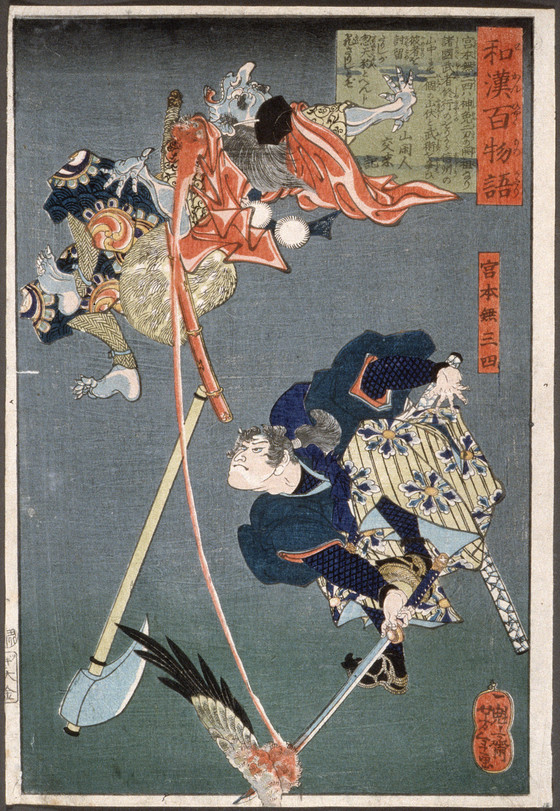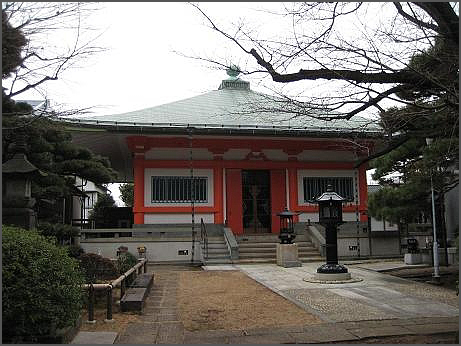[ . BACK to DARUMA MUSEUM TOP . ]
. Tengupedia - 天狗ペディア - Tengu ABC-Index .
::::::::::::::::::::::::::::::
Koorinboo 宰府高垣高林坊 / 宰府高垣高森坊 Korin-Bo
Korinbo, Saifu Takagaki - Fukuoka
He is one of the
. 四十八天狗 48 Important Tengu of Japan .
He lived on Hoomanzan 竈門山(宝満山) Mount Homanzan, on the border between 筑紫野市 Chikushino
and 大宰府町 Dasaifu.

Mount Hōman
The mountain is about 830 m high.
It is an important site for Shugendo, and a famous place for rock climbing.
- quote wikipedia-
杖道発祥の地 Mount Homanzan is the place where"the Way of the Stick" to defend oneself originated.
..............................
- quote -
Jōdō 杖道 Jodo literally means the way of the stick.
Shinto Muso Ryu (SMR) evolved in the castle town of Fukuoka, in the north west of the main southern island of Kyushu.
SMR is a 17th Century art that matches a practitioner equipped with a 4-shaku 2-sun 1-bu (128 cm) long stick against a swordsman. In its complete "old school" (koryu) form SMR comprises seven sets of jo kata, and several ancillary weapon sets including kenjutsu, walking stick (tanjo), sickle and chain (kasuirgama), war fan (tessen) and other arts besides.
It was founded by Musō Gonnosuke Katsuyoshi, a master swordsman of the Tenshin Shoden Katori Shinto Ryu who embarked on warriors quest (musa shugyo), travelling Japan, looking for opponents to duel.
SMR tradition relates that he met Miyamoto Musashi (possibly in Edo) suffering his only defeat to the two sword (Nito) technique. Following this he travelled seeking answers to the juji-dome block.
At Mount Homan in Kyushu,
above the castle town of Fukuoka he spent 37 days meditating and training – and received a revelation from the Tengu (long-nosed winged demons, famous as the source of several martial traditions) to take the round pole and place it on the water of the moon (Water Moon, or Suigetsu, is the Japanese word used in budo to indicate the solar plexus on the human body).
- source : seitei-iaido-seitei-jodo-
..............................
- quote -
Musō Gonnosuke Katsuyoshi 夢想權之助勝吉 Muso Gonnosuke
was a samurai of the early 17th century and the traditional founder of the Koryu school of jojutsu known as
Shintō Musō-ryū (神道夢想流 / 神道無想流) Shinto Muso-Ryu.

He is perhaps most famous for his duels with the legendary swordsman Miyamoto Musashi.
- His first duel with Miyamoto Musashi
- Seclusion, Jojutsu and the second duel
The outcome of the second duel, or even that a second duel occurred, is not conclusively known. The stick-fighting school he founded maintains that Gonnosuke, now armed with the jo, defeated Musashi through the use of the superior length of the jo to keep Musashi's swords out of range of Gonnosuke and thus hinder him from using the X-shaped technique effectively. Gonnosuke had Musashi at his mercy but let him live as a way of returning the favour granted in the first duel. ...
- - - More in the WIKIPEDIA !
..............................
宝満宮竈門神社 Homan-Gu Kamado Jinja
883 Uchiyama, Dazaifu, Fukuoka

- - - - - Deities in residence
Tamayori-hime, Emperor Ōjin, Empress Jingū
From the 中宮 Middle Shrine the 行者道 Shugendo Path begins.
About half way up there is the Tengudo 天狗道 Tengu Path, but this is now forbidden for hikers and tourists.
- HP of the shrine
- source : kamadojinja.or.jp -
::::::::::::::::::::::::::::::
. Miyamoto Musashi 宮本武蔵 (1584 - 1645) .
- Introduction -

source : collections.lacma.org
Miyamoto Musashi Slashing a Tengu
Alternate Title: 宮本無三四
by Tsukioka Yoshitoshi (1839 - 1892)
..............................
And was the great Miyamoto Musashi not nicknamed "the little Tengu",
he who remained undefeated after more than sixty duels ?
- reference : miyamoto musashi tengu -
..............................

by Utagawa Hiroshige (1797 - 185)
..............................
Tengu Geijutson 天狗芸術論 The Demon's Sermon on the Martial Arts
Discourse of the God Tengu on the Art of the Sword
Neko no myoojutsu 猫の妙術 Neko no Myojutsu
The Cat's Eerie Skill / The Cat's Uncanny Skill / The Mysterious Technique of the Cat
佚斎樗山 Issai Chozan (Chozanshi) (1659 - 1741)
Die wunderbare Kunst einer Katze
tr. Karlfried Graf Dürckheim (1896-1988)

- quote -
This collection of parables written by an eighteenth-century samurai is a classic of martial arts literature. The tales are concerned with themes such as perception of conflict, self-transformation, the cultivation of chi (life energy), and understanding yin and yang. Some of the parables seem light and fanciful, but they offer the reader valuable lessons on the fundamental principles of the martial arts; "The Mysterious Technique of the Cat" is iconic.
The "demon"
in the title story refers to the mythical tengu, who guard the secrets of swordsmanship. A swordsman travels to Mt. Kurama, famous for being inhabited by tengu, and in a series of conversations he learns about mushin (no-mind), strategy, the transformation of chi, and how the path of the sword leads to the understanding of life itself.
The author, Issai Chozanshi,
had a deep understanding of Taoism, Buddhism, Confucianism, and Shinto, as well as insight into the central role of chi in the universe—points that are succinctly explained in William Scott Wilson's fine introduction and extensive endnotes. This is essential reading for anyone who wants to truly understand the philosophical underpinnings of martial arts, and how these principles relate to our existence.
- source : shambhala.com... -

..............................
- quote -
A Graphic Approach to Musashi and Demons: Shambhala's "The Book of Five Rings"
and
"The Demon's Sermon on the Martial Arts"

..... The story revolves around a young would-be swordsman who ventures into the deep woods to seek the instruction of the tengu, the mythical bird-men of Japan who were said to have instructed the legendary hero Minamoto no Yoshitsune in the ways of warfare. Coming across a group of them holding a discussion in a tree, he settles in to eavesdrop and benefit from their wisdom. The title is somewhat of a misnomer-tengu aren't demons in the Western sense of the word (that being malevolent beings or spirits from Hell) but more like 'forest spirits'. Wilson here chooses to break "The Demon's Sermon" into several parts and use it as a framework to structure the shorter stories. This allows the short stories to reinforce and expand upon the concepts brought up by the tengu, as well as letting the tengu introduce the concepts to be spotlighted in the short stories.
An interesting choice by Wilson, it helps to tie the work together as a unified whole rather than a series of stories. Many of the ideas are the same as those looked at by Musashi in "Five Rings", again showing how Buddhist and Confucian ideals found their way into sword training. The tengu discuss the concept of no-mind or emptiness, using your chi (the energy that flows through everything) correctly, the importance of practice and discipline, and how adaptability and lack of attachment are vital.
Humorously, the tengu also find most martial arts schools to be lacking in their instruction with too great an emphasis on rigid technique.
- source : theshogunshouse.com/2013 -
::::::::::::::::::::::::::::::
- reference - 宰府高垣高林坊 -
- reference : fukuoka homan shrine -
- reference : issai chozan -
- reference : The Demon's Sermon -
::::::::::::::::::::::::::::::

. - - - Join my Tengupedia friends on facebook ! - - - .
::::::::::::::::::::::::::::::
. Tengu 天狗と伝説 Tengu legends "Long-nosed Goblin" .
. - yookai, yōkai 妖怪 Yokai monsters - .
. Legends and Tales from Japan 伝説 - Introduction .
. Mingei 民芸 Regional Folk Art from Japan .
::::::::::::::::::::::::::::::
[ . BACK to DARUMA MUSEUM TOP . ]
[ . BACK to WORLDKIGO . TOP . ]
- #korinbo #miyamotomusashi #kamadojinja -
::::::::::::::::::::::::::::::
--
Posted By Gabi Greve to Kappa - The Kappapedia on 1/30/2017 09:50:00 am








































